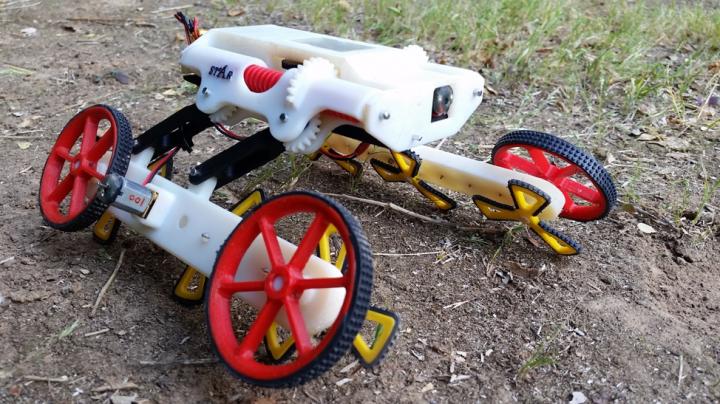New creepy, crawly search and rescue robot developed at Ben-Gurion U

Ben-Gurion University of the Negev researchers designed the Rising Sprawl-Tuned Autonomous Robot (RSTAR) to function simply and reliably, change shape and overcome common obstacles without any external mechanical intervention. RSTAR uses adjustable sprawling legs angled downwards and outwards from its body to creep and crawl and climb over and through a variety of obstacles and surfaces. Credit: Ben-Gurion University of the Negev
A new highly maneuverable search and rescue robot that can creep, crawl and climb over rough terrain and through tight spaces has been developed by Ben-Gurion University of the Negev (BGU) researchers.
The new Rising Sprawl-Tuned Autonomous Robot (RSTAR) utilizes adjustable sprawling wheel legs attached to a body that can move independently and reposition itself to run on flat surfaces, climb over large obstacles and up closely-spaced walls, and crawl through a tunnel, pipe or narrow gaps. See video.
The innovative BGU robot was introduced at the International Conference on Robotics and Automation (ICRA 2018) in Brisbane, Australia, May 21-25.
“The RSTAR is ideal for search and rescue operations in unstructured environments, such as collapsed buildings or flooded areas, where it must adapt and overcome a variety of successive obstacles to reach its target,” says Dr. David Zarrouk, a lecturer in BGU's Department of Mechanical Engineering, and head of the Bio-Inspired and Medical Robotics Lab. “It is the newest member of our family of STAR robots.”
Dr. Zarrouk and BGU student and robotics lab worker Liran Yehezkel designed RSTAR to function simply and reliably, change shape and overcome common obstacles without any external mechanical intervention. Its speed and relatively low energy consumption make the robot ideal for a broad range of applications that may require longer work time.
The robot uses its round wheels to travel more than three feet per second on hard flat surfaces and switches to spoke wheels to traverse extremely soft or granular surfaces, like thick mud or sand, without getting stuck. It also climbs vertically and crawls horizontally by pressing its wheels to walls without touching the floor.
The BGU team is working on a larger STAR robot version that will climb over larger obstacles, including stairs, and carry more than four pounds of sensors and supplies. A smaller STAR or RSTAR will piggyback on the larger robot to use in hard-to-reach areas and sneak in between narrow cracks and passages.
This BGU research was supported in part by the Helmsley Charitable Trust through the Agricultural, Biological and Cognitive Robotics Initiative (ABC Robotics) and by the BGU Marcus Endowment Fund. The Marcus legacy gift, in excess of $480 million, was donated in 2016 to American Associates, Ben-Gurion University of the Negev by Dr. Howard and Lottie Marcus to establish the significant endowment fund. The donation is the largest gift given to any Israeli university and is believed to be the largest gift to any Israeli institution.
About American Associates, Ben-Gurion University of the Negev
American Associates, Ben-Gurion University of the Negev (AABGU) plays a vital role in sustaining David Ben-Gurion's vision: creating a world-class institution of education and research in the Israeli desert, nurturing the Negev community and sharing the University's expertise locally and around the globe. As Ben-Gurion University of the Negev (BGU) looks ahead to turning 50 in 2020, AABGU imagines a future that goes beyond the walls of academia. It is a future where BGU invents a new world and inspires a vision for a stronger Israel and its next generation of leaders. Together with supporters, AABGU will help the University foster excellence in teaching, research and outreach to the communities of the Negev for the next 50 years and beyond. Visit vision.aabgu.org to learn more.
AABGU, which is headquartered in Manhattan, has nine regional offices throughout the United States. For more information, visit http://www.
Media Contact
All latest news from the category: Power and Electrical Engineering
This topic covers issues related to energy generation, conversion, transportation and consumption and how the industry is addressing the challenge of energy efficiency in general.
innovations-report provides in-depth and informative reports and articles on subjects ranging from wind energy, fuel cell technology, solar energy, geothermal energy, petroleum, gas, nuclear engineering, alternative energy and energy efficiency to fusion, hydrogen and superconductor technologies.
Newest articles

First-of-its-kind study uses remote sensing to monitor plastic debris in rivers and lakes
Remote sensing creates a cost-effective solution to monitoring plastic pollution. A first-of-its-kind study from researchers at the University of Minnesota Twin Cities shows how remote sensing can help monitor and…

Laser-based artificial neuron mimics nerve cell functions at lightning speed
With a processing speed a billion times faster than nature, chip-based laser neuron could help advance AI tasks such as pattern recognition and sequence prediction. Researchers have developed a laser-based…

Optimising the processing of plastic waste
Just one look in the yellow bin reveals a colourful jumble of different types of plastic. However, the purer and more uniform plastic waste is, the easier it is to…



